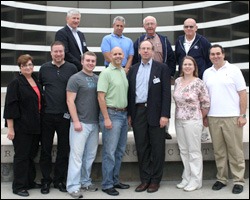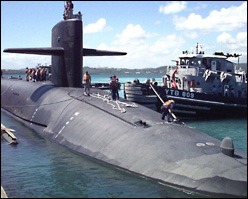JINSA Group Briefed on Navy’s Ballistic Missile Submarine Ops at Kings Bay Base
 On November 19, a JINSA delegation visited U.S. Naval Submarine Base Kings Bay, the east coast homeport of the U.S. Navy’s nuclear-powered Ohio-class ballistic missile submarines.
On November 19, a JINSA delegation visited U.S. Naval Submarine Base Kings Bay, the east coast homeport of the U.S. Navy’s nuclear-powered Ohio-class ballistic missile submarines.
 On November 19, a JINSA delegation visited U.S. Naval Submarine Base Kings Bay, the east coast homeport of the U.S. Navy’s nuclear-powered Ohio-class ballistic missile submarines. The boats, also known as Trident submarines for the 24 nuclear-tipped Trident ballistic missiles they carry, form one third of America’s nuclear deterrent arsenal along with the Air Force’s air- and ground-based missiles. Rear Admiral George Voelker, USN (Ret.), an alumnus of JINSA’s Flag and General Officers Trip to Israel, personally led the JINSA group. R. Adm. Voelker spent his career in the submarine community.
On November 19, a JINSA delegation visited U.S. Naval Submarine Base Kings Bay, the east coast homeport of the U.S. Navy’s nuclear-powered Ohio-class ballistic missile submarines. The boats, also known as Trident submarines for the 24 nuclear-tipped Trident ballistic missiles they carry, form one third of America’s nuclear deterrent arsenal along with the Air Force’s air- and ground-based missiles. Rear Admiral George Voelker, USN (Ret.), an alumnus of JINSA’s Flag and General Officers Trip to Israel, personally led the JINSA group. R. Adm. Voelker spent his career in the submarine community.
Kings Bay, located in St. Marys, Georgia just north of Jacksonville, Florida, is the home of Submarine Group 10, composed of Submarine Squadrons 16 and 20, and the day began with a briefing about Sub Group 10 and the base’s key tenant commands that include the Maritime Force Protection Unit (MFPU), Strategic Weapons Facility Atlantic (SWFLANT), Marine Corps Security Force Battalion, the Trident Refit Facility (TRF) and the Trident Training Facility (TTF).
The commander of Submarine Group 10, Rear Admiral Barry L. Bruner, USN, is the senior commander at Kings Bay and is the subordinate commander to Vice Adm. John J. Donnelly, commander of the U.S. Atlantic Fleet Submarine Force. R. Adm. Bruner has command over all the units assigned to Kings Bay including operational and administrative control of Submarine Squadrons 16 and 20. R. Adm. Bruner exercises direct control over the administration and training of submarine off-crews at Kings Bay. Specifically included in these responsibilities are the proper integration and coordination of the facilities dedicated to training support of the Trident system.
The MFPU is a single mission unit of the U.S. Coast Guard whose responsibility is providing escorts for departing and returning submarines. Because submarines are at their most vulnerable when surfaced, the protection afforded by the MFPU is crucial to the safety of the fleet. Serving a similar purpose on land, the Marine Corps Security Force Battalion protects SWFLANT as well as the waterfront.
Strategic Weapons Facility Atlantic provides support for the nuclear warhead-armed strategic missiles. SWFLANT is responsible for assembling the Trident II (D-5) ballistic missile as well as processing missile guidance and launcher subsystem components. The D-5 missile is at the heart of the Trident Weapons System and has a greater range, payload and accuracy than its predecessors including the Trident C-4 and the Polaris ballistic missiles.
Since 1985, the Trident Refit Facility has overhauled, modernized and repaired the Ohio-class submarine fleet utilizing the largest covered dry dock in the northern hemisphere at 700 feet long, 100 feet wide and 67 feet deep. In addition to its responsibilities for the fleet, the TRF also provides repair services to the Navy’s Nuclear Power Training Unit in Charleston, SC, maintenance and support to other submarines, regional customers.
The TRF houses the Magnetic Silencing Facility, which provides degaussing services (eliminating unwanted magnetic fields) and deperming services (eliminating permanent magnetism) from both U.S. and UK submarines and surface craft. Additionally, the TRF operates the Defensive Ordnance Support Facility tasked with maintaining and storing torpedoes carried by Ohio-class submarines.
Following the briefing, the JINSA group toured the Trident Training Facility. The TTF trains sailors in the skills necessary to operate and maintain the submarines. Each boat has two crews, a Blue crew and a Gold crew. Each crew is made up of approximately 160 members. While one crew is out to sea (for approximately three months), the other spends its time learning advanced skills at the TTF. This rotational arrangement allows each submarine to stay at sea approximately 70 percent of the year.
Impressive in size and scope (it is the second largest Department of Defense building, only the Pentagon is bigger), the TTF has all components of a submarine set up in the building as trainers. New submariners as well as seasoned crew members receive “virtual” training on everything from piloting the boats to extinguishing equipment fires. Every aspect of the boat from the bridge to the torpedo loading system is faithfully reproduced to provide submariners experience on the actual components they use while at sea. Because the submarines are on patrol for several months at a time, crew members must be proficient in performing repairs on every piece of equipment and even fabricating necessary parts if none are available in the boat’s stores.
 The highlight of the day was the opportunity to board the dry-docked USS Maryland (SSBN-738). Seeing the Maryland out of water really allowed the group to understand the breathtaking size of the Ohio-class submarines. During the morning briefing the JINSA group was shown a graphic of an Ohio-class boat superimposed on two football fields (which was a pretty abstract concept), but seeing it out of water really makes an impression. The boat is simply massive. At 560 feet long (just shy of the height of the Washington Monument) and 42 feet wide, it is the largest submarine type in the Navy’s fleet. The Ohio-class submarines are but seven feet shorter in length that the Navy’s Ticonderoga-class guided missile cruisers and displace 18,750 tons, more than twice that of the cruisers.
The highlight of the day was the opportunity to board the dry-docked USS Maryland (SSBN-738). Seeing the Maryland out of water really allowed the group to understand the breathtaking size of the Ohio-class submarines. During the morning briefing the JINSA group was shown a graphic of an Ohio-class boat superimposed on two football fields (which was a pretty abstract concept), but seeing it out of water really makes an impression. The boat is simply massive. At 560 feet long (just shy of the height of the Washington Monument) and 42 feet wide, it is the largest submarine type in the Navy’s fleet. The Ohio-class submarines are but seven feet shorter in length that the Navy’s Ticonderoga-class guided missile cruisers and displace 18,750 tons, more than twice that of the cruisers.
The Maryland, one of 18 Ohio-class submarines in the U.S. Navy fleet, carries up to 24 Trident D-5 missiles each capable of carrying 12 multiple independently targetable reentry vehicles (MIRV) warheads. By mutual agreement with the Soviet Union and its Russian successor, the START I Treaty reduced the number of warheads per missile to eight and the follow on Strategic Offensive Reductions Treaty (SORT) reduced the maximum payload yet further to 4 or 5 per missile.
Between 2002 and 2008, the U.S. Navy modified the four oldest Ohio-class submarines to the SSGN configuration (“G” for guided missiles), converting 22 of the 24 ballistic missile launch tubes for vertical launching systems containing seven smaller Tomahawk cruise missiles giving each SSGN the capability to carry up to 154 Tomahawk missiles. The two remaining tubes were converted to lock out chambers to be used by special operations personnel entering and exiting the submerged boats.
The tubes can also be used to carry and launch unmanned aerial vehicles or unmanned underwater vehicles which would give the submarine remote controlled “eyes and ears” allowing the ship to act as a forward-deployed command & control center.
Despite wires and tubing strewn around the Maryland’s labyrinthine interior spaces as she underwent an extensive overhaul, it was easy to see how well utilized the space inside is. Through the tour, the group had the opportunity to see what amounted to but a small portion of the boat that included the bridge, missile tubes, missile control room, torpedo room, officers’ quarters, crew quarters, galley and the officer and enlisted messes while getting ample exercise climbing up and down various ladders.
Even being in dry-dock with armed Marine guards stationed at the gangway and on top of the boat; armed sailors were aboard the submarine stationed at critical points of the missile system as well. The missile hatches themselves are guarded around the clock as well as the control room. Although it is impossible to unintentionally fire a missile, three crew members (two of whom are armed) man the missile control system. In order to initiate the launch of a live missile, three “keys” are required along with an order from the President of the United States. When on full alert, a missile can be launched “in less than a lunch break” upon receiving notification from the President and obtaining codes to free the system “keys.”
 Ohio-class ballistic missile submarines are also armed with Mark 48 Advanced Capability torpedoes carrying 650-lb warheads. The Mark 48, launched from the boat’s four tubes, can be operated with or without wire guidance and with active or passive acoustic homing. The Mark 48’s range is up to 50km at a speed of 40kt. After launch the torpedo carries out target search, acquisition and attack procedures to a depth of 3,000 ft. The torpedoes are loaded through a narrow hole in the top three decks of the boat.
Ohio-class ballistic missile submarines are also armed with Mark 48 Advanced Capability torpedoes carrying 650-lb warheads. The Mark 48, launched from the boat’s four tubes, can be operated with or without wire guidance and with active or passive acoustic homing. The Mark 48’s range is up to 50km at a speed of 40kt. After launch the torpedo carries out target search, acquisition and attack procedures to a depth of 3,000 ft. The torpedoes are loaded through a narrow hole in the top three decks of the boat.
While the opportunity to experience the USS Maryland was unique and thrilling, the JINSA group left with a great appreciation for the submariners who serve this country. These proud men spend months at a time away from their families, isolated deep under the ocean in “Silent Service” to protect the freedoms that we all enjoy.
“Of all the branches of men in the forces there is none which shows more devotion and faces grimmer perils than the submariners.” – Sir Winston Churchill